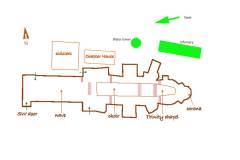Basics
Geology: A metamorphic rock
Age: Various
Where to see examples
Stele near the water tower (images 1-3 below)
Deller memorial
Everlasting wall plaque in War Memorial garden
Description
Slate is a generic term for a fine-grained, low-grade metamorphic rock that has formed from a sedimentary mudstone. During a compressional event the platy minerals, such as clays and micas, in the mudstone are aligned perpendicular to the direction of maximum pressure producing a distinct cleavage in the rock. This cleavage can be exploited by the slate worker to produce many slates from a single block of stone. Slates have been used for building roofs, floor surfaces, sculpted works and numerous other purposes. Slate is often dark grey in colour, but can occur in various colours reflecting different mineral components within the original sediments.
There are many slate outcrops in the British Isles, most associated with ancient mountain building periods, when sometimes thick sequences of mudstones were compressed and uplifted. The examples illustrated here include slates quarried in Cumbria (the stele) and Cornwall (Alfred Deller’s memorial plaque).



